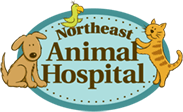Pet Obesity…Fat or Fluffy?
.jpg)
We all know we should eat healthily and exercise, but what about our pets? Without them, we may notice our pet is getting a bit “fluffier.” But how fluffy is too fluffy? Pet obesity is defined as being 15-20% over your individual pet’s ideal body weight. Up to 44% of pets in North America are obese, which can be caused by underlying health issues, lack of exercise, or simply loving our pets too much and giving them too much of a good thing—food and treats.
Once fat cells are formed, they can be shrunken down with calorie restriction and exercise, but they are permanent. For this reason, dogs that become overweight as puppies have more trouble maintaining or losing weight and are more likely to be obese in adulthood. Thus, it is very important to prevent obesity at an early age.
How do I know if my pet is overweight?
It can be hard to determine what the ideal weight for your pet is, as even within breeds of dogs and cats, the skeletal structure can vary greatly. Take a Chihuahua, for example, we’ve seen some fully grown 3-pound adults, but also some 12-pound adults. Does that mean the 12-pound Chihuahua is morbidly obese? Not necessarily, the 12-pound Chihuahua can be perfectly lean and trim for its skeletal size. For this reason, veterinarians use a visual scale along with the traditional scale to determine ideal body weight. A very thin pet would have visible ribs, spine, and hip bones. A very obese pet would have a layer of fat over its ribs, fat deposits in front of the hips, and near the neck, and a rounded belly. A pet at an ideal body weight would have ribs that are easily felt without pushing through a layer of fat, an abdomen that is tucked up when viewed from the side, and a visible last rib.
Does it matter if my pet is chubby?
Overweight pets are at risk for a variety of health problems, including skin infections, high blood pressure, heart disease, immune suppression diabetes, arthritis, and some forms of cancer. Obesity also increases the risk of complications with surgery and anesthesia.
What can you do?
If you know or suspect your pet has some weight to lose, we can help you determine if there’s a health issue to blame, if a reduced calorie/high fiber diet is needed, help you structure a feeding plan, and give you some ideas for exercise that doesn’t require just running your dog around the neighborhood. Together, we can help reduce or eliminate the need for certain medications required to manage medical disorders and help them live a longer, happier life!
